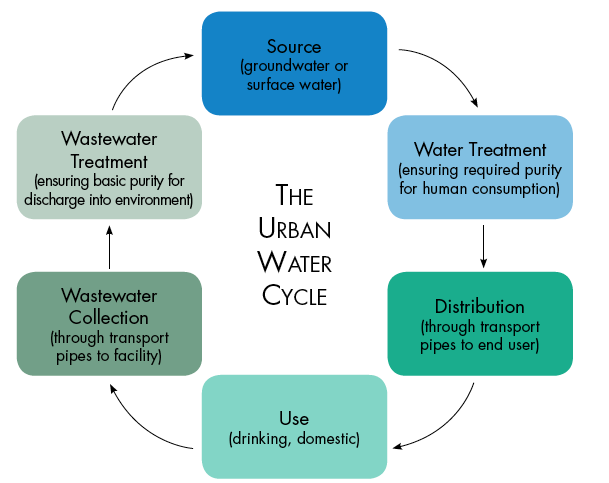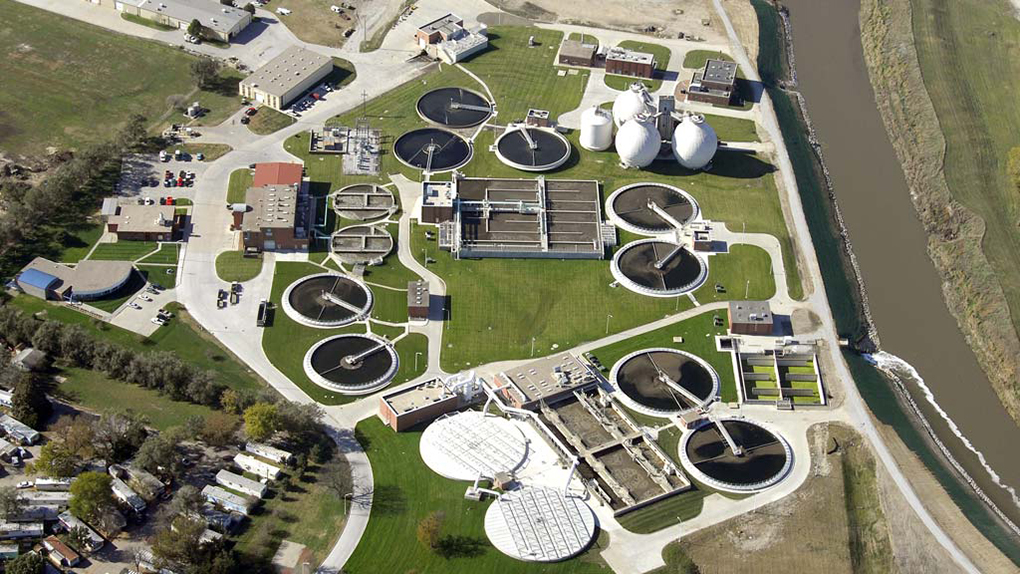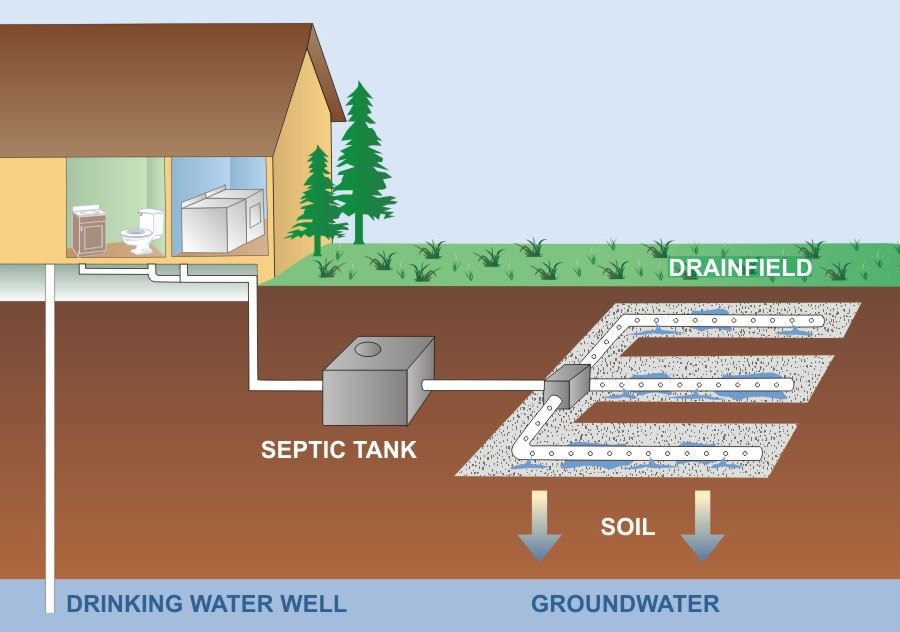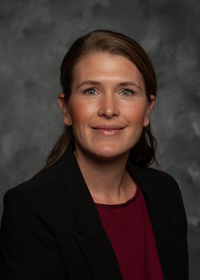Water: Sink to Sea
“Conservation is a state of harmony between men and land.” – Aldo Leopold
To understand how humans interact with water, one needs to understand the water, or hydrologic, cycle, which transports water on global scales in natural environments. We often forget how drastically humans have altered that cycle on local scales. This dramatic alteration is especially evident within cities where natural hydrologic processes are changed and we engage in a different water cycle—the urban water cycle (Figure 1). Fifty-four percent (3.5 billion) of the world’s population live in cities, and this number is expected to grow to more than 65 percent by 2050 (United Nations 2014; Rhodan 2013). In America, 62.7 percent of the population live in cities (U.S. Census Bureau 2015).

Growing urban populations put pressure on public water systems and create major challenges for securing ample clean water for the future. Whether for drinking water, domestic uses, food production, transportation, or manufacturing, humans rely on water for many basic needs and widespread conveniences. Understanding how humans interact with and impact the water cycle is the first step in protecting our water resources.
Urban Water Cycle
In the natural water cycle, water moves between continuous processes of evaporation, condensation, precipitation, and surface and groundwater exchange. Some of the transport processes can take a very long time to occur. Aquifers, for example, recharge via precipitation that infiltrates the soil and geological profile, which can take decades to centuries. Humans impact water resources by altering the transport pathways and moving water resources between storage compartments at rates that are faster than natural rates. Other impacts include introducing often-harmful contaminants that are unlikely to occur in natural water systems. Let’s take a look at some major components of the urban water cycle, how humans interact with water in the cycle, and ways we can do our part to ensure human and environmental safety.
Municipal Water Sources and Pretreatment
Household water comes from surface and/or groundwater sources. Surface water sources include lakes, reservoirs, and rivers—these are the most visible and are often tapped for public water supplies. Groundwater is found beneath the earth’s surface and is another primary source of water for human use. Many factors influence which type of water source is used to meet human demands, including accessibility, quality, availability, proximity, economics, and legality. Despite the water source, in public systems, water is typically treated before it is transported to customers’ homes, and the wastewater leaving homes also has to be treated to make sure it is safe to be discharged into the environment.
Water resources for public supply systems are typically treated before distribution for human use. Treatment ensures the removal of harmful contaminants and pathogens. Some homes have private wells that pull groundwater for domestic use, such as for drinking; groundwater is typically safe for drinking directly from the source.
Water is transported from a surface or groundwater source to a water-treatment facility, where sediment and harmful microorganisms are removed. Disinfection is an important step that kills harmful microorganisms in water. Additional treatment steps are necessary or desired; these include a sequence of screening, settling, filtering, disinfecting, and making chemical adjustments to reduce health risks and improve water taste and odor. Once treated, water is distributed right to customers’ taps through public water supply pipes (distribution system) belowground.
Wastewater Treatment
After we use water, whether for bathing, watering the lawn, cooking, or flushing the toilet, it all goes down the drain. But then where does it go? In a similar fashion to water distribution, wastewater collection systems transport water from customers through sewer pipes to wastewater-treatment facilities (Figure 2). This system often includes storm drain systems (i.e., combined sewer overflows) that collect surface water runoff and transport it to facilities along with customer wastewater. Wastewater-treatment or management facilities are common in developed countries. A wastewater-treatment facility (or plant) consists of multiple structures, designed specifically to manage and treat human waste, solid waste, sewage, and stormwater—collectively referred to as wastewater.

Wastewater must go through a treatment process before it can be discharged into the environment. Wastewater treatment consists of physical, chemical, and biological processes to remove waste and ensure that acceptable water is released into the environment.
The first step in the wastewater-treatment process is primary treatment of solids and large particles that are filtered out of the water using screens and large settling tanks. Once large particles are removed, the wastewater still contains small organic particles, suspended solids, and chemical and biological contaminants that need to be removed.
Next is secondary treatment, where bacteria and other microorganisms are used to reduce the amount of organic waste through chemical decomposition in a process referred to as activated sludge. The activated sludge process uses larger tanks with aeration and mixing apparatuses followed by a settling pond to separate the liquid and solids. Solids are then either composted on-site or transported and disposed of in a nearby landfill. While landfills are an important component in the current waste-management system, the waste in landfills is a source of air and groundwater pollution. To remediate this issue, some municipalities use composting to create methane gases that run generators and help to power the treatment plant.
To complete the secondary treatment, water is disinfected using chlorine or ultraviolet light to kill bacteria before being discharged into receiving waters. Some municipalities use treatment wetlands as a method either to improve water quality coming into the plant or further treat water leaving the plant. Cleaned water is released back into surface waters and re-enters the hydrologic cycle.
Septic Systems
For homeowners with on-site waste-treatment systems or septic systems, the treatment process is a bit different. A septic system is an underground waste-treatment system used in rural areas where centralized public systems are less economical or logistically feasible. A septic system has two main parts: a septic tank and a drainfield (Figure 3). The septic tank is a sealed container that receives waste flows from the home and holds them long enough for solids and liquids to separate.

The waste separates into three layers: greases and oils float to the top, solids settle to the bottom, and partially clarified water remains in the middle layer. The clarified liquid layer flows out of the holding tank into the drainfield, or into distribution devices that disperse the water into the drainfield. A drainfield can be a series of trenches or a bed lined with gravel or coarse sand buried 1–3 feet below the ground surface. Water pumped into the drainfield moves through the gravel and soil, which act as a biological filter to clean the water. This is similar to the natural water filtration process.
Unfortunately, due to improper treatment, failure to treat, or declining infrastructure, contaminated water is occasionally released back into the environment, and it can be a serious source of pollution within the U.S. It is also important to remember that the hydrologic cycle is global; when we put something in the water, it can be transported almost anywhere in the world.
Aging Water Infrastructure
Wastewater-treatment systems are crucial for maintaining public health and sanitation and for reducing environmental impacts to receiving waters. However, these systems are a source of greenhouse gas emissions and require important physical-structure maintenance and technology upgrades over time. The average life expectancy of a sewer system is 15–20 years. Due to the physical infrastructure required for a facility, they are often designed to process a specific amount of waste per day, based on the population the facility is intended to serve. This is problematic as urban populations continue to grow. Large collection and treatment systems are needed.
The estimated total cost of wastewater and stormwater treatment and collection in the U.S. was $271 billion as of January 1, 2012 (EPA 2012). That estimate includes capital needs for publicly owned wastewater pipes and treatment facilities ($197.8 billion), combined sewage overflow correction ($48 billion), stormwater management ($19.2 billion), and recycled water treatment and distribution ($6.1 billion). These numbers indicate that taxpayers and policymakers will have to find ways to support and implement projects that maintain our wastewater infrastructure to ensure clean drinking water sources and to maintain the effectiveness of wastewater treatment to protect the environment.
It’s important to make smart choices regarding water use. Knowing the source of your drinking water is the first step toward protecting it. The next article in this series will focus on watersheds and how we can protect the watersheds we live in.
References
City of Lincoln, Nebraska. Lincoln Wastewater System.
Rhodan, M. 2013. U.N.: Number of City-Dwellers to Double by 2050.
Snohomish County, Washington. “Septic Systems.”
Sowby, Robert B. 2014. “The Urban Water Cycle: Sustaining Our Modern Cities.” National Geographic.
United Nations. 2014. World’s population increasingly urban with more than half living in urban areas.
U.S. Census Bureau. 2015. U.S. Cities Home to 62.7% of Population but Comprise 3.5% of Land Area.
U.S. Environmental Protection Agency. 2012. Clean Watersheds Needs Survey 2012: Report to Congress.
Publication 3074 (POD-06-23)
By Beth Baker, PhD, Associate Extension Professor, Austin Omer, former Extension Associate, and Caleb Aldridge, former Research Associate, Wildlife, Fisheries, and Aquaculture.
The Mississippi State University Extension Service is working to ensure all web content is accessible to all users. If you need assistance accessing any of our content, please email the webteam or call 662-325-2262.



